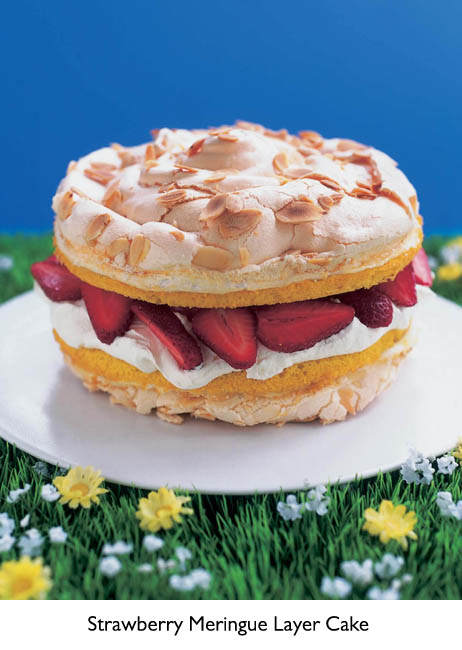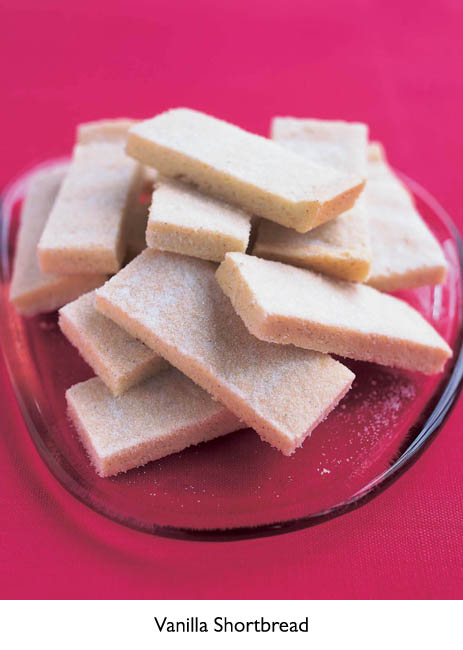Forever Summer (27 page)
Authors: Nigella Lawson

Serves 8–10 with the generous addition of berries and cream or mascarpone.
EASTERN MEDITERRANEAN CHEESECAKE
To be true to this cheesecake’s provenance, you would be using kaymak, a rich, creamy curd cheese made of buffalo milk; I’ve let you off with a mixture of curd cheese, cream cheese and soured cream instead. Does this make it authentic? I don’t know: but it is authentically good. For me that’s enough. I make no claims other than that.
This is not a cheesecake as one might usually expect: there is no biscuit base, no base of any sort indeed; and the taste and texture is similarly different: there’s not that melting, mouth-filling richness, but something altogether lighter and more flutteringly fragrant. The whisked egg whites give it a delicate almost-moussiness; the orange-flower water, honey and cinnamon provide a light aromatic tang. It needs no accompaniment: serve just as it is.
50g soft unsalted butter
100g caster sugar
1 tablespoon plain flour
250g curd cheese
250g cream cheese
150ml soured cream
2 tablespoons orange-blossom honey
5 eggs, separated
1 tablespoon orange-flower water
1 teaspoon ground cinnamon
1 tablespoon caster sugar
2–3 tablespoons flaked almonds
Preheat the oven to 160°C/gas mark 3. Butter and line a 23cm Springform tin.
Cream together the butter and the sugar until light and fluffy, with the instrument of your choice (mine’s a Kitchen Aid; a hand-held electric whisk would be fine), then add the flour. Gently beat in the curd and cream cheeses and the soured cream, and then the honey and egg yolks. Finally add the orange-flower water.
In a separate bowl, whisk the egg whites until they are stiff but not dry, and fold them into the cheese mixture. Pour into the tin, and then dust the top with the cinnamon and caster sugar and then sprinkle over the flaked almonds.
Cook in the oven for an hour – it will rise up and crack but that’s just what it does – then turn the oven off and leave the cake in there for another hour, and it will sink back into the tin.
Take the cheesecake out of the oven and let cool in the tin on a wire rack, before springing it open when you want to eat it.
Serves 6–8.
STRAWBERRY MERINGUE LAYER CAKE
This is another Oz-emanating recipe, one I scribbled down from a friend once after a gardenside, Sunday’s summer lunch. And you should know that I have never made it myself without some other friend asking me, in turn, for the recipe as well. Pavlova meets Victoria sponge is, give or take, what it is: but, as lazy luck would have it, much simpler to make than that or its ceremonious title would suggest.
125g plain flour
25g cornflour
1 and a half teaspoons baking powder
100g very soft unsalted butter
300g caster sugar
4 eggs
2 teaspoons pure vanilla extract
2 tablespoons milk
50g flaked almonds
375ml double cream
250g strawberries
Preheat the oven to 200°C/gas mark 6. Line, butter and flour 2 x 22cm Springform tins.
Weigh out the flour, cornflour and baking powder into a bowl.
Cream the butter and 100g of the caster sugar in another bowl until light and fluffy. Separate the eggs and beat the yolks into the butter and sugar, saving the whites to whisk later. Gently fold in the weighed-out dry ingredients, add the vanilla, and then stir in the milk to thin the batter. Divide the mixture between the two prepared Springform tins.
Whisk the egg whites until soft peaks form, then gradually add the remaining 200g caster sugar. Spread a layer of meringue on top of the sponge batter in each tin, and sprinkle the almonds evenly over.
Bake for 30–35 minutes, by which time the top of the almond-scattered meringues will be a dark gold. Let the cakes cool in their tins, then spring them open at the last minute when you are ready to assemble the cake.
Whip the double cream, and hull and slice the strawberries; that’s to say, the bigger ones can be sliced lengthways and the smaller ones halved. Invert one of the cakes on to a plate or cakestand so that the sponge is uppermost. Pile on the cream and stud with the strawberries, letting some of the berries subside into the whipped whiteness. Place the second cake on top, meringue upwards, and press down gently, just to secure it.
If you’ve got any more strawberries in the house, hull and halve them, and serve them in a dish on a table to eat alongside; it gives the cake a more after-lunch, less afternoon-tea kind of a feel, but it’s hardly obligatory.
Serves 8.

RHUBARB FOOL
This is old-fashioned, nostalgia-perfect English summer in pudding form: vanilla-scented, rhubarb-rippled, totally dreamy.
Make sure you use the rosiest, reddest rhubarb you can: that monster stuff, dredged up almost khaki at the very end of August, will not quite do here. I don’t want to anger the nation’s greengrocers, but I’ve found Marks & Spencer’s sell rhubarb that is reliably pink all the year around. And it’s hardly seasonal to mention it, but of course the purest, pucest stalks are the forced kind that fill the shops after Christmas: no matter, you will want to eat this whenever you can.
If you haven’t got any vanilla sugar to hand (though you can have, just by leaving a vanilla pod or two in a jar of caster sugar for a few days, even less if you cut the pod up), use ordinary caster sugar and add a teaspoon of pure vanilla extract to the cream when you whip it. This recipe is not Simon Hopkinson’s but is wholly, chest-swellingly inspired by it.
I deviate sometimes from it in the summer months – actually, throughout the year, now I come to think of it – by following exactly the same rhubarb-cooking method, but instead of doing anything with it further, I serve it simply as it is, roasted to tender pinkness, to be eaten still warm, with
egg-custard ice cream
. Or just use a tub of good shop-bought vanilla instead.
1kg rhubarb, trimmed and coarsely chopped
300g vanilla sugar
500ml double cream
Preheat the oven to 190°C/gas mark 5.
Mix the rhubarb and vanilla sugar together in an ovenproof dish. Do not add water. Cover with foil and bake for 45 minutes to 1 hour or until the fruit is completely soft. Drain in a colander, or sieve, and pour the juice (you should have about 500ml) into a saucepan, then heat and let bubble away until reduced by about half. Pour into a jug and leave to cool; do not, however, refrigerate as the syrup might crystallise and lose its fabulous puce clarity. Purée the fruit until totally smooth, then cool and chill this as well.
Whip the cream in a large chilled bowl until lusciously thick but not stiff. Carefully fold in the rhubarb purée, then some of the reduced juice, so the mixture is streaked, rather like raspberry ripple ice cream. Put the juice in a glass jug so that people can add more, if they want, as they eat. Or frankly, you could instead use half the amount of rhubarb juice in the pan for reducing and use the remaining 250ml for adding to champagne for a fabulous, blush-pink summer drink.
I know that the saying goes that you cannot improve on perfection, but just make a batch of
vanilla shortbread
to go with…
Serves 8.

VANILLA SHORTBREAD
I know that biscuits sound like the sort of cooking someone else does, but you need never have baked anything ever in your life to be able to make these with untroubled ease. And I hate to say this – as someone with a once-serious Bahlsen habit – but they are so much better than anything out of a packet.
100g icing sugar
200g plain flour, preferably Italian 00
100g cornflour
200g very soft unsalted butter
seeds from 1 vanilla pod
vanilla or ordinary caster sugar for sprinkling
Preheat the oven to 160°C/gas mark 3.
Put the icing sugar, plain flour and cornflour into the bowl of a food processor fitted with the double-bladed knife and give them a quick blitz (just to save you sieving, which is my most-hated job in the kitchen) before adding the butter along with the vanilla seeds you’ve scraped out of a pod. (I find the easiest way to do this is by cutting the pod in half across, and then splitting each short half lengthwise and prising out the seeds with the point and edge of a sharp knife. Don’t even think of throwing the deseeded bits of pod away: stash them in a jar of caster to use next time a recipe requires vanilla sugar.)
Process again until the soft mixture coheres and begins to form a ball, loosely clumping around the blade. Turn this out on to a Swiss roll tin and press to form an even (or as even as you can make it) layer, using fingers or the back of a spoon, or both. Be patient: I promise you it will fit smoothly.
Using the tip of a sharp knife cut the pressed-out shortbread into fingers. I make two incisions lengthways – ie to form three layers – and then make ten cuts down – so that you end up with eleven fingers per layer. Obviously, the aim should be to cut at regular intervals but don’t start getting your ruler out. Just go by eye: uniformity is the province of the conveyer belt not of home cooking. Use the tines of a fork to make little holes in each marked-out biscuit: I press down about three times, diagonally, on each finger.
Now that you’ve pressed, incised, and punctured, slide the Swiss roll tin into the oven and bake for about 20–25 minutes, by which time the shortbread will be pale still, but not doughy. Expect a little goldenness around the edges, but shortbread should be not crisp but melting. Remove the tin from the oven and let cool for 10 minutes or so, before removing, with a palette knife and your fingers, to a wire rack. Sprinkle with sugar and leave them to cool completely before storing in a tin.
Makes 33 fingers.

PASSIONFRUIT SHORTCAKES
Shortcakes are one of America’s great culinary contributions, somewhere between sponge cake and scone, over there sandwiched with (often) sweetened cream and strawberries, but I love them too like this, Oz-style: the cream softly whipped and innocent of vanilla or sugar, and with almost astringently aromatic passionfruit scooped out on top. It’s the perfect ending to a garden-fragrant summer lunch.
A more Anglo-version, to be eaten on an idyll of a blue-skied afternoon, replaces the scooped-out passionfruit with rubied dollops of hands-free, home-made fresh raspberry jam. This is so simple, so effortless and so summery, that I have to reprise the recipe, quickly, from
How To Be A Domestic Goddess
: put 250g raspberries into one ovenproof dish and 250g caster sugar into another (a flat, round pie-dish shape is best). Cook both in an oven preheated to 180°C/gas mark 4 for 20–25 minutes, then remove from the oven and add the hot sugar to the hot berries. As you do so, so your jam is made, an instant, molten, red-gleaming river of it. Pour into a 250ml jar and leave to cool and set before storing in the fridge. Spoon out on to cream-clouded shortcakes, as suggested – or eat any way pleasure suggests.
